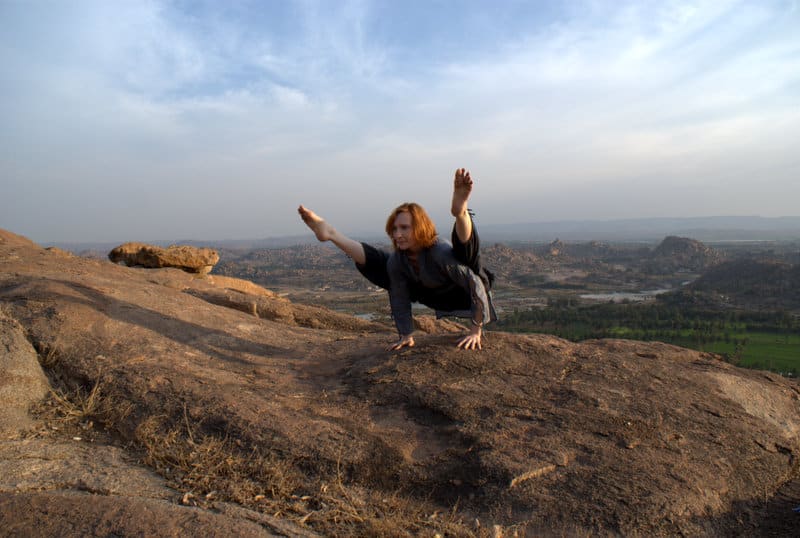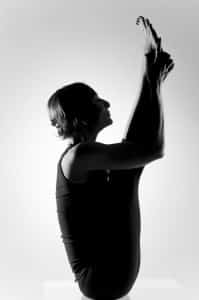Ashtanga vinyasa yoga practitioners often call this form of yoga briefly Ashtanga * (1), skipping the key word Vinyasa. Unfortunately oftentimes the vinyasa in not present in the practice either. Incorrect understanding of vinyasa and its importance results in forgetting about its basic aspect – breathing.
Ashtanga vinyasa yoga is very spectacular, fixed series of asanas allow practitioners to perform them without thinking, and the transitions (vinyasas) between static postures make the practice dynamic. Focus on asana and its skillfull performance appears to be erroneous and pernicious approach to practice, because the foundation of ashtanga vinyasa yoga is breathing. Undoubtedly every teacher emphasizes the importance of the breath since the beginning of teaching – there’s no practice without ujjayi breath. It is emphasized that the inhalations and exhalations should be of equal length and that the breath should be relaxed, that the breath sets the pace of the practice. That’s how it should be – it should but often it’s not the case.
The key aspect of this form of yoga is vinyasa. Vinyasa is not the sequence of asanas nor it is just a sequence of postures linked with the breath. It means integration of the movement with the breath. By vinyasa we understand more than fluid sequence that links static postures (although it’s this aspect of the practice that’s called vinyasa in ashtanga vinyasa yoga practice). Performing asanas in synchronization with the breath is also a vinyasa. David Swenson wrote in his book:
“Through vinyasa one may know the vibration of life. This integration manifests when the act of breathing and movement cease to be separate entities” *(2)
The Breath and the movement become one. There is no vinyasa without integration of the movement with the breath! In order for this to happen, the breath must be conscious.
As Ashtanga vinyasa yoga teacher with several years of experience, I know that while giving classes to beginners you can’t introduce asanas, ujjayi breathing, bandhas and drishti all at the same time, although they are very important and should integrate as a whole. For the novice it‘s impossible to focus on all those elements at the same time.
Beginners focus mainly on asanas and their performance forgetting about the breath (not to mention bandhas). That’s why it seems most appropriate to introduce subsequent elements step by step. I think that the process of learning ashtanga vinyasa yoga should start by developing awareness of the breath, observing the breath and finding its rhythm that suits best the practitioner. Then – in short and simple sequences – you can introduce the synchronization of the movement with the breath (eg. raising hands on inhalation into tadasana samasthitiḥ, lowering them down on exhalation; inhalation – urdhva mukha svanasana, exhalation – adho mukha svanasana). In the same time you can introduce ujjayi breath because some of the students will need more time and body awareness before they’ll be able to feel it.
It is important to adapt the movement to the length of the breath, and not the other way. The breath – inhalation or exhalation – begins a second before the movement; during vinyasa the movement continues over the entire length of the inhalation or exhalation – this is the factor that gives a feeling of fluidity, of performing dance movement. It is just as if breathing was causing the movement, the breath leads and places the body into the postures. Being in asana, you create it by working with the breath (eg. inhalation stretches the spine, exhalation brings relaxation). Once the integration of the movement with the breath starts to be conscious, you can teach the whole series and introduce bandhas.
In the beginning it’s good to share series into short sequences that, when repeated by students on their own, will allow them to adapt the movement to their breathing pattern and to remember the order of the asanas. Bandhas on the other hand are important when the practice becomes uniform, because they are too difficult to master in the beginning due to lack of awareness of the body most students have. Focusing on drishti point is best taught in the beginning while teaching simple asanas by directing the eye to the right place – that should develop the ability of finding intuitively drishti in variousdifferent positions.
I have sort of impression that this form of yoga suits dynamic, hyperactive people who like the feeling of physical fatigue, which gives them the satisfaction of having done something for the body. Impatience and desire to perform more asanas, as well as difficult, spectacular variants of transitions between them, may be the cause of forgetting the basis of this practice, this is working with the body through the breath.
As I mentioned, there is no ashtanga vinyasa yoga without ujjayi breath. The specific sound of this breath is sometimes compared to the sound of the waves or Darth Vader’s breathing. 🙂 Ujjiayi breath loudness is very individual. It happens that in order to make it stronger and more audible, too much tension is generated in the throat or that too much effort is put into maintaining strong breath and that causes disintegration and loss of control over it. Breathing should be free, quiet and without any strain. Quiet doesn’t mean forcefully extended but maintainedin a comfortable way. Freedom of the breath can be gained by finding your own rhythm of the breath, that can be maintained during the entire practice.
While speaking about ashtanga vinyasa yoga people use words like flow, fluidity, even meditation in motion. However the fluidity can’t be achieved just by linking asanas into logical sequences, where one position builds on the previous one, without integration of the movement with the breath.


